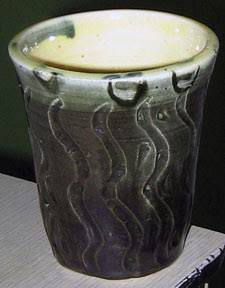As Jerry Seinfeld would say, "What's the deal with that?"
I applied for the Peace Corps early this year, planning to leave for service in January or February after my graduation. Then a wonderful job offer intervened, and my plans are, for now, postponed.
Since then, though, I've discovered that there are at least three Returned Peace Corps Volunteers (RPCVs) who regularly work at the ACC. Laura, a doctoral student in forestry, served in Ecuador just a few years ago. Lynne became a supervolunteer (someone who signs on for an extra year of service) in Africa. And Nancy was among the first ever Peace Corps volunteers in the early 1960s. She served as a teacher in Latin America.
According to the PC, about 190,000 Americans have served since the first crop went overseas in 1963. That's out of 300 million people. I did the math to try to figure out the percentage and got a lot of Es. So let's just say that RPCVs are overrepresented at the ACC.
This is much more than a coincidence. But what could it be? I think that the types of folks who are attracted to the Peace Corps are also the types who like pottery. It's hands-on. It offers satisfaction for your creativity. It's an ancient art form that has been practiced by most of the world's cultures. It's a little bit unorthodox. Instead of catching prime time TV, we potters are chatting about chemicals and plasticity in a windowless basement. We're oohing and aahing over a dish that took 10 times more time and money than it would to pick it up at Wal-Mart. We're hippies.
Perhaps the attribute of hippies that best explains this phenomenon is the importance of community. I've often pondered as I get closer to leaving Gainesville how much the ACC has meant for me. I made my very first Gainesville friend at the ACC. To quote Cheers, it's the place where everybody knows your name. It's a place where people with very different lives (an elderly nude model), many different ages (college students and retirees) and many different ethnicities (Brazil, Mexico, Argentina, Spain are all represented) come together to talk on the same level. Where competition is put aside and an individual's experience benefits all. These are people who, like Peace Corps volunteers, believe in the principle of community and probably couldn't imagine life without it.
A fine one they have built.
Friday, October 26, 2007
Thursday, October 25, 2007
A sill full of cups

Now that fall is upon us, I am prepared. The mugs I've made over the last few weeks are out of the kiln, and we now have more options for containers to drink tea, coffee and hot chocolate from than you'd ever need. The collection grew so large we had to move it to the window sill. As a bonus, a few of them double as beer steins. We are in college, after all, and this is Florida, after all. There are only so many steamy bevs you'll want to drink before you start hankering after a frothier brew.
The latest duo of mugs I made, the prettiest of which is below (Lydia Yellow sprayed over Floating Red, for you ACC folks out there), are a little tall. I knew that at the time but decided I didn't care. They're very attractive, in my opinion, but aren't terribly functional as mugs. For one thing, you'll be shaking like a crack addict after drinking the amount of coffee that fits in this cup. Not to imply that this photo is of a crack addict. It's my boyfriend, Casey.

Monday, October 22, 2007
My pots are going into the whaaa?
This week I've gotten a lot more pots out of the...
Which brings me to the subject of my post. I had always heard the word pronounced "kiln," just like it's written, from my high school days huddling in the kiln room in winter because it was the only warm spot in the studio.
Then I come to the ACC and our beloved Mary Ann Bonner says "kil." First I thought I was just hearing it wrong, but it's been long enough now. Besides, I'm quite positive my friend Thom, former clay guy in the basement, also pronounced it in a way that suggests it's a place where pots go to die.
So I thought I would use the glory of the Internet to settle the dispute. (I should add that I have etymology on the mind since I'm taking Chaucer with the famed R.A. Shoaf). Wasn't to be. American Heritage lists "kiln" as the most accepted pronunciation. But Random House says it's "kil" first. And where does Merriam-Webster weigh in, you journalists might ask? "Kiln."
On the other hand, there is a place called Kiln, Miss., and my boyfriend's grandmother is from there. They pronounce it "Kil."
Which brings me to the subject of my post. I had always heard the word pronounced "kiln," just like it's written, from my high school days huddling in the kiln room in winter because it was the only warm spot in the studio.
Then I come to the ACC and our beloved Mary Ann Bonner says "kil." First I thought I was just hearing it wrong, but it's been long enough now. Besides, I'm quite positive my friend Thom, former clay guy in the basement, also pronounced it in a way that suggests it's a place where pots go to die.
So I thought I would use the glory of the Internet to settle the dispute. (I should add that I have etymology on the mind since I'm taking Chaucer with the famed R.A. Shoaf). Wasn't to be. American Heritage lists "kiln" as the most accepted pronunciation. But Random House says it's "kil" first. And where does Merriam-Webster weigh in, you journalists might ask? "Kiln."
On the other hand, there is a place called Kiln, Miss., and my boyfriend's grandmother is from there. They pronounce it "Kil."
Saturday, October 13, 2007
Complementary colors

My very first babies of the semester are out of the oven. I've been working with red clay because of its earthiness and lack of grit, and I started out with a glaze that I know works well on red clay (Thanks to Reisa, who discovered this combo). It's called Ice Blue in our studio, and it tends to be fairly runny and translucent. It brings out a bright red tone in the clay and complements it well where thicker.
Thursday, October 11, 2007
Ceramics: Nietsche's eternal return?
Thanks to my course in the Intellectual History of Europe, I can't get my mind off Friedrich Nitzsche, a powerful philosopher and writer who appeals to my doubts about religion. One idea in particular I found relevant to a thought I've had about potting for a long time.
Clay is a mysterious substance, because it allows complete control but later is perpetual. Let me explain. Nothing is more malleable than plastic clay -- one of the lessons pottery teachers will hammer home is that any move you make, any contact you have with the clay, will be recorded. Pulling your hand off the rim too quickly will make the form wobble off center. Forgot to cut your fingernails? The clay will remember with tiny crescent moons. If you don't fix these things, they will be remembered forever by the clay once it's fired. I have an example for you -- a pot that (like most) recorded my laziness about glazing.

See those fingerprints? They'll be there when the archaeologists of the future dig up what's left of Gainesville.
Nietzsche comes in with the idea of eternal return, which wasn't his originally, according to Wikipedia, but he reintroduced to the 20th century. In physics, the concept is that the universe will contract and expand infinitely, so that each configuration of the universe and time is repeated. For Nietzsche, it was more a thought than a belief, a sort of device that allowed you to see life more clearly. If a being came and announced that your life would recur endlessly to you in your loneliest moment, it would seem a curse. If it came in a moment of light, it would seem like a blessing. For Nietzsche, this is the "heaviest weight," one that places incalculable importance on every experience we have. Every decision, every move, carries a hesitancy if you consider life in this way. The notion appears in Czech writer Milan Kundera's novel The Unbearable Lightness of Being and in the Bill Murray movie Groundhog Day.
It seems to me that the nature of clay is parallel to this idea and maybe even a metaphor for it. Life can be as open to possibility as clay is. But the moment that you place a pot on the shelf to be fired, you have to consider whether the work you have done is worthy of lasting forever. If something endures, is it the same as eternal recurrence? It seems to me that it is so.
Clay is a mysterious substance, because it allows complete control but later is perpetual. Let me explain. Nothing is more malleable than plastic clay -- one of the lessons pottery teachers will hammer home is that any move you make, any contact you have with the clay, will be recorded. Pulling your hand off the rim too quickly will make the form wobble off center. Forgot to cut your fingernails? The clay will remember with tiny crescent moons. If you don't fix these things, they will be remembered forever by the clay once it's fired. I have an example for you -- a pot that (like most) recorded my laziness about glazing.

See those fingerprints? They'll be there when the archaeologists of the future dig up what's left of Gainesville.
Nietzsche comes in with the idea of eternal return, which wasn't his originally, according to Wikipedia, but he reintroduced to the 20th century. In physics, the concept is that the universe will contract and expand infinitely, so that each configuration of the universe and time is repeated. For Nietzsche, it was more a thought than a belief, a sort of device that allowed you to see life more clearly. If a being came and announced that your life would recur endlessly to you in your loneliest moment, it would seem a curse. If it came in a moment of light, it would seem like a blessing. For Nietzsche, this is the "heaviest weight," one that places incalculable importance on every experience we have. Every decision, every move, carries a hesitancy if you consider life in this way. The notion appears in Czech writer Milan Kundera's novel The Unbearable Lightness of Being and in the Bill Murray movie Groundhog Day.
It seems to me that the nature of clay is parallel to this idea and maybe even a metaphor for it. Life can be as open to possibility as clay is. But the moment that you place a pot on the shelf to be fired, you have to consider whether the work you have done is worthy of lasting forever. If something endures, is it the same as eternal recurrence? It seems to me that it is so.
Subscribe to:
Comments (Atom)

